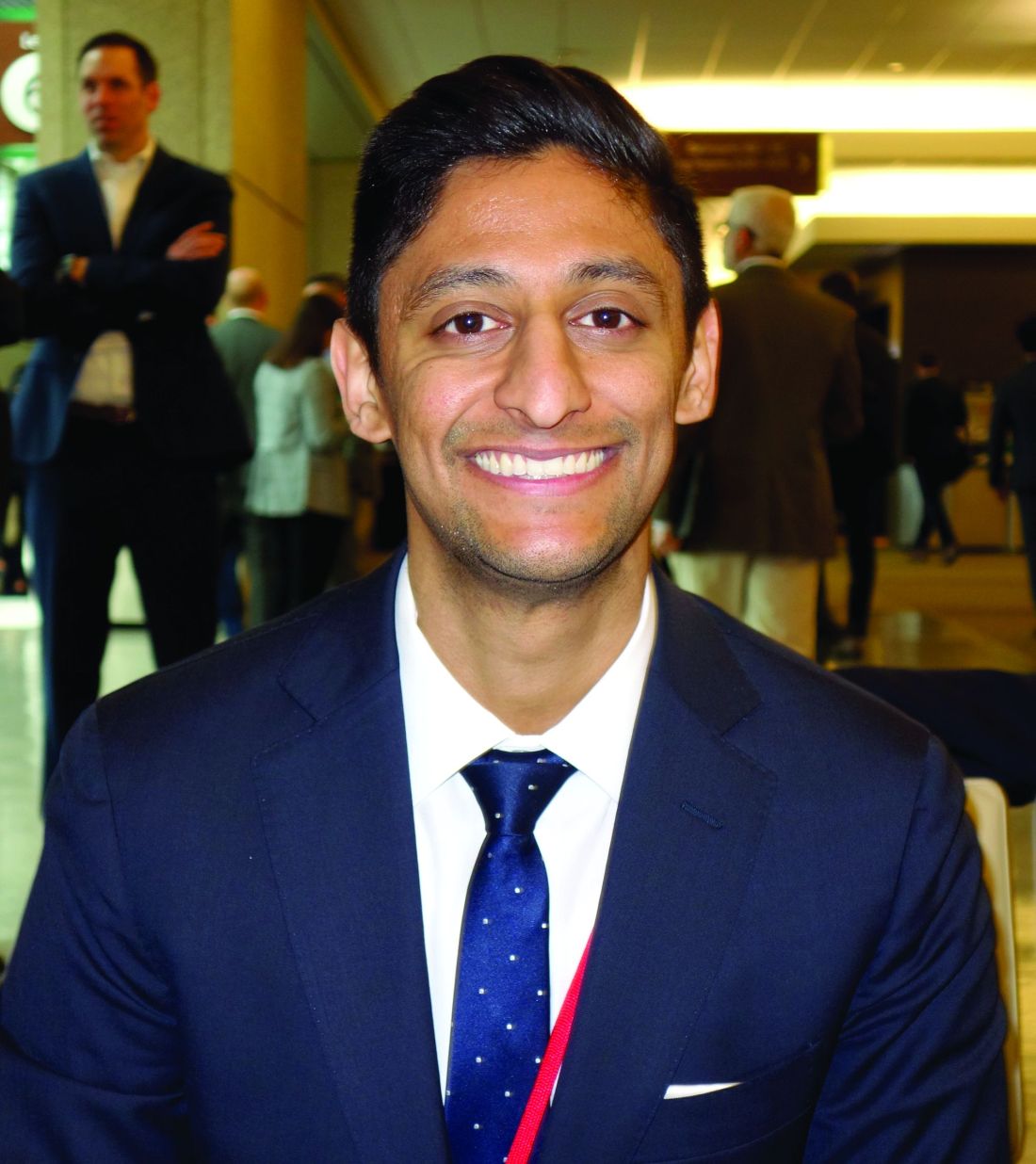User login
SEATTLE – Endoscopic stent migration fell from 41% of stent cases to 15% after surgeons at Lenox Hill Hospital, New York, started to secure stents with a single, proximal figure-of-eight overstitch.
Anastomotic leaks are a major and potentially fatal complication of bariatric surgery. Stents are one of the fix options: An expanding tube is rolled down over the wound to take the pressure off and give it time to heal. The stent is removed after the leak closes, which can take a few weeks or longer.
Stents designed specifically for the procedure will likely address the problem in the near future, but for now, the overstitch helps at Lenox Hill. Meanwhile, “it’s important to [realize] that stent migration did not adversely impact [bariatric surgery] failure rates, nor was migration associated with the incidence of revision surgery,” said surgery resident Varun Krishnan, MD.
Dr. Krishnan was the lead investigator on a review of 37 leak cases at Lenox Hill from 2005 to 2017, 17 before overstitch was begun in 2012, and 20 afterwards, with follow-up out to 71 months. The results were presented at the World Congress of Endoscopic Surgery hosted by SAGES & CAGS. The senior investigator was Lenox Hill surgeon Julio Teixeira, MD, FACS, associate professor of medicine at Hofstra University, Hempstead, N.Y. He reported the first use of stents for bariatric leaks in 2007 (Surg Obes Relat Dis. 2007 Jan-Feb;3[1]:68-71).
The goal of the review was to address lingering concerns about long-term effects of stents on weight loss and other issues. In the end, “our experience with stenting has been very positive. It’s a very good [option] for treating leaks after bariatric surgery,” Dr. Krishnan said,
The overall success rate was 95%. The 2 failures were both in the sleeve gastrectomy patient group, which made up 43% of the 37 leak cases. The leaks were fixed in one sleeve patient with conversion to a Roux-en-Y gastric bypass, and the other with a stent redo. Both were in the overstitch group.
“We had better success with gastric bypass [patients], probably due to anatomy,” Dr. Krishnan noted. Sleeves leave patients with higher intraluminal pressures, which complicate leak healing.
Stents didn’t have any impact on weight loss. Patients lost a mean of 57% of their excess body weight over an average of 21 months.
Out of 20 patients with available data, 5 were readmitted for oral intolerance, another major concern with endoscopic stents; 3 had their stents removed because of it. None required total parenteral nutrition.
Among 17 patients with available data, 7 (41.7%) had poststent reflux; all of them reported proton-pump inhibitor histories.
Of the 37 total cases, 15 patients (41%) had Roux-en-Y bypasses. The remaining six bypass patients received either duodenal switches or foregut procedures.
Two sleeve and four bypass patients (16%) had revisions. One was the conversion to bypass after stent failure, but the others were for intussusception, strictures, reflux, and other problems that didn’t seem related to stents. About six patients were restented, the one case for stent failure plus five or so for migration.
Patients were an average of about 40 years old, and 70% were women. Average preop body mass index was over 40 kg/m2. The one death in the series was from fungal sepsis a year after stent removal.
In response to an audience question, Dr. Krishnan noted that the distal tip of the stent was placed just after the gastrojejunal anastomosis in bypass cases. Also, bariatric surgeons do the endoscopy at Lenox Hill and place the stents.
The investigators did not report any relevant disclosures, and there was no outside funding.
SEATTLE – Endoscopic stent migration fell from 41% of stent cases to 15% after surgeons at Lenox Hill Hospital, New York, started to secure stents with a single, proximal figure-of-eight overstitch.
Anastomotic leaks are a major and potentially fatal complication of bariatric surgery. Stents are one of the fix options: An expanding tube is rolled down over the wound to take the pressure off and give it time to heal. The stent is removed after the leak closes, which can take a few weeks or longer.
Stents designed specifically for the procedure will likely address the problem in the near future, but for now, the overstitch helps at Lenox Hill. Meanwhile, “it’s important to [realize] that stent migration did not adversely impact [bariatric surgery] failure rates, nor was migration associated with the incidence of revision surgery,” said surgery resident Varun Krishnan, MD.
Dr. Krishnan was the lead investigator on a review of 37 leak cases at Lenox Hill from 2005 to 2017, 17 before overstitch was begun in 2012, and 20 afterwards, with follow-up out to 71 months. The results were presented at the World Congress of Endoscopic Surgery hosted by SAGES & CAGS. The senior investigator was Lenox Hill surgeon Julio Teixeira, MD, FACS, associate professor of medicine at Hofstra University, Hempstead, N.Y. He reported the first use of stents for bariatric leaks in 2007 (Surg Obes Relat Dis. 2007 Jan-Feb;3[1]:68-71).
The goal of the review was to address lingering concerns about long-term effects of stents on weight loss and other issues. In the end, “our experience with stenting has been very positive. It’s a very good [option] for treating leaks after bariatric surgery,” Dr. Krishnan said,
The overall success rate was 95%. The 2 failures were both in the sleeve gastrectomy patient group, which made up 43% of the 37 leak cases. The leaks were fixed in one sleeve patient with conversion to a Roux-en-Y gastric bypass, and the other with a stent redo. Both were in the overstitch group.
“We had better success with gastric bypass [patients], probably due to anatomy,” Dr. Krishnan noted. Sleeves leave patients with higher intraluminal pressures, which complicate leak healing.
Stents didn’t have any impact on weight loss. Patients lost a mean of 57% of their excess body weight over an average of 21 months.
Out of 20 patients with available data, 5 were readmitted for oral intolerance, another major concern with endoscopic stents; 3 had their stents removed because of it. None required total parenteral nutrition.
Among 17 patients with available data, 7 (41.7%) had poststent reflux; all of them reported proton-pump inhibitor histories.
Of the 37 total cases, 15 patients (41%) had Roux-en-Y bypasses. The remaining six bypass patients received either duodenal switches or foregut procedures.
Two sleeve and four bypass patients (16%) had revisions. One was the conversion to bypass after stent failure, but the others were for intussusception, strictures, reflux, and other problems that didn’t seem related to stents. About six patients were restented, the one case for stent failure plus five or so for migration.
Patients were an average of about 40 years old, and 70% were women. Average preop body mass index was over 40 kg/m2. The one death in the series was from fungal sepsis a year after stent removal.
In response to an audience question, Dr. Krishnan noted that the distal tip of the stent was placed just after the gastrojejunal anastomosis in bypass cases. Also, bariatric surgeons do the endoscopy at Lenox Hill and place the stents.
The investigators did not report any relevant disclosures, and there was no outside funding.
SEATTLE – Endoscopic stent migration fell from 41% of stent cases to 15% after surgeons at Lenox Hill Hospital, New York, started to secure stents with a single, proximal figure-of-eight overstitch.
Anastomotic leaks are a major and potentially fatal complication of bariatric surgery. Stents are one of the fix options: An expanding tube is rolled down over the wound to take the pressure off and give it time to heal. The stent is removed after the leak closes, which can take a few weeks or longer.
Stents designed specifically for the procedure will likely address the problem in the near future, but for now, the overstitch helps at Lenox Hill. Meanwhile, “it’s important to [realize] that stent migration did not adversely impact [bariatric surgery] failure rates, nor was migration associated with the incidence of revision surgery,” said surgery resident Varun Krishnan, MD.
Dr. Krishnan was the lead investigator on a review of 37 leak cases at Lenox Hill from 2005 to 2017, 17 before overstitch was begun in 2012, and 20 afterwards, with follow-up out to 71 months. The results were presented at the World Congress of Endoscopic Surgery hosted by SAGES & CAGS. The senior investigator was Lenox Hill surgeon Julio Teixeira, MD, FACS, associate professor of medicine at Hofstra University, Hempstead, N.Y. He reported the first use of stents for bariatric leaks in 2007 (Surg Obes Relat Dis. 2007 Jan-Feb;3[1]:68-71).
The goal of the review was to address lingering concerns about long-term effects of stents on weight loss and other issues. In the end, “our experience with stenting has been very positive. It’s a very good [option] for treating leaks after bariatric surgery,” Dr. Krishnan said,
The overall success rate was 95%. The 2 failures were both in the sleeve gastrectomy patient group, which made up 43% of the 37 leak cases. The leaks were fixed in one sleeve patient with conversion to a Roux-en-Y gastric bypass, and the other with a stent redo. Both were in the overstitch group.
“We had better success with gastric bypass [patients], probably due to anatomy,” Dr. Krishnan noted. Sleeves leave patients with higher intraluminal pressures, which complicate leak healing.
Stents didn’t have any impact on weight loss. Patients lost a mean of 57% of their excess body weight over an average of 21 months.
Out of 20 patients with available data, 5 were readmitted for oral intolerance, another major concern with endoscopic stents; 3 had their stents removed because of it. None required total parenteral nutrition.
Among 17 patients with available data, 7 (41.7%) had poststent reflux; all of them reported proton-pump inhibitor histories.
Of the 37 total cases, 15 patients (41%) had Roux-en-Y bypasses. The remaining six bypass patients received either duodenal switches or foregut procedures.
Two sleeve and four bypass patients (16%) had revisions. One was the conversion to bypass after stent failure, but the others were for intussusception, strictures, reflux, and other problems that didn’t seem related to stents. About six patients were restented, the one case for stent failure plus five or so for migration.
Patients were an average of about 40 years old, and 70% were women. Average preop body mass index was over 40 kg/m2. The one death in the series was from fungal sepsis a year after stent removal.
In response to an audience question, Dr. Krishnan noted that the distal tip of the stent was placed just after the gastrojejunal anastomosis in bypass cases. Also, bariatric surgeons do the endoscopy at Lenox Hill and place the stents.
The investigators did not report any relevant disclosures, and there was no outside funding.
REPORTING FROM SAGES 2018
Key clinical point: Consider fixation when endoscopic stents are used for bariatric surgery leaks.
Major finding: Endoscopic stent migration fell from 41% of stent cases to 15% after surgeons at Lenox Hill Hospital, New York, started to secure stents with a single, proximal figure-of-eight overstitch.
Study details: A review of 37 leak cases
Disclosures: The investigators did not report any relevant disclosures, and there was no outside funding.

